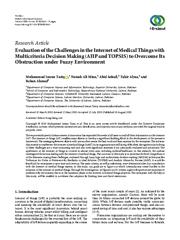A copy of this work was available on the public web and has been preserved in the Wayback Machine. The capture dates from 2020; you can also visit the original URL.
The file type is application/pdf.
Evaluation of the Challenges in the Internet of Medical Things with Multicriteria Decision Making (AHP and TOPSIS) to Overcome Its Obstruction under Fuzzy Environment
2020
Mobile Information Systems
The exponential speed of advancement of innovation has expanded the needs of all users to avail all their information on the Internet 24/7. The Internet of things (IoT) enables smart objects to develop a significant building block in the development of the pervasive framework. The messaging between objects with one another means the least work and least expense for the enterprise. The industry that intends to implement the Internet of medical things (IoMT) in its organizations is still facing
doi:10.1155/2020/8815651
fatcat:k5acmxkphzejhmteebhu434uyq

